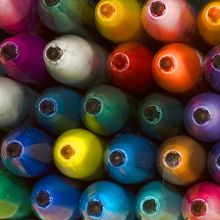Wikis > Practical Tips for Fluorescent Western Blots
Here are some practical tips from Advansta for every step of your fluorescent Western blot.
Tissue Preparation
-
Make sure samples are completely lysed to maximize recovery of proteins.
-
Keep samples cold to prevent protein degradation.
-
Use protease inhibitors in lysis buffer to prevent degradation of the sample.
-
Determine the protein concentration of each sample to calculate the amount of sample to load on the gel.
-
When freezing samples, make small aliquots to prevent multiple freeze-thaws.
Electrophoresis
-
Make sure the gel has no imperfections and is properly set before using.
-
Heat samples prior to loading to break secondary structures. Use a reducing agent when required.
-
Make sure the well size is appropriate for the sample volume to prevent carryover of samples.
-
Do not overload the lane with too much protein; it will cause distortion of the lane.
-
If using fluorescent molecular weight markers, skip a lane before loading test samples in case the signal from the markers is intense.
-
Run the gel at the correct voltage: running the gel at a voltage that is too high can cause fuzzy bands or “smiling” bands.
-
Avoid the use of bromophenol blue which autofluoresces and can cause high background.
Transfer
-
Handle the membrane with gloved hands to prevent marks on the membrane.
-
Use “powder-free” gloves. Particles in powdered gloves can stick to membranes and cause high background.
-
Wash gloved hands before handling membranes and minimize direct contact with working areas. Even non-powdered gloves can contain a tiny amount of residual process chemicals that stick to membranes and cause background or other artifacts.
-
Wash all transfer equipment including transfer pads to reduce background.
-
Make sure PVDF membrane is pre-wetted with methanol.
-
Remove all air bubbles when setting up the transfer sandwich to prevent incomplete transfer or fuzzy bands.
-
Optimize the transfer conditions.
-
Alter the concentration of SDS and methanol in transfer buffer to increase transfer efficiency.
-
Decrease transfer time for smaller proteins, increase transfer time for larger proteins.
-
Use a high performance transfer buffer such as FLASHBlot to enhance transfer efficiency and increase protein retention on the membrane.
-
-
Chill transfer setup if necessary to prevent overheating.
-
Use a pencil to mark the blot as some inks autofluoresce.
Blocking
-
Prepare blocking buffer fresh just before use to prevent contamination and high background.
-
Filter the blocking solution to prevent clumps that will stick to the membrane causing speckles and blotches.
-
Completely solubilize detergent in the blocking buffer prior to use to prevent high background.
-
Optimize the blocking agent to reduce background and increase signal.
-
Be aware that excessive blocking can mask some antigens. Use 1% milk rather than 5%.
-
Try different blocking agents to reduce background.
-
Primary antibodies can recognize components of blocking agents causing high background.
-
Some detection reagents cross-react with blocking solutions.
-
Try a blocking agent optimized for fluorescent detection, such as AdvanBlock-PF.
-
-
-
Use a TBS-based buffer system when detecting phospho-proteins.
-
Do not use milk-based blockers or casein if you plan to use any biotinylated antibody and streptavidin detectors. Milk contains biotin and will cause high background when combined with these reagents.
Incubations and Washes
-
Keep all containers and solutions free of dirt to prevent background on blot.
-
Cover containers when incubating or washing blot to prevent particulates from falling onto the blot.
-
Use a shaker to prevent uneven distribution of buffers.
-
Increase wash time to decrease high background.
-
Decrease wash time to increase signal.
-
Photobleaching is not a concern during incubations and washes – perform these steps on the bench.
Antibodies
-
Store fluorescent antibodies in a light-protected box.
-
Make sure the primary antibody can detect the protein of interest under the conditions used (i.e. some antibodies only recognize tertiary structures in native proteins).
-
Titrate antibodies to yield highest signal-to-noise ratio. Fluorescent Westerns often require different antibody concentrations than chemiluminescent Westerns.
-
Primary antibodies may need to be increased 2-5 fold.
-
Secondary antibodies may also need to be increased (1:5000 recommended starting dilution.)
-
-
To decrease general background, dilute the secondary antibody further.
-
To decrease multiple bands that are non-specific, dilute the primary antibody further.
-
Use positive and negative control samples to make sure the antibody is detecting the right target.
-
Centrifuge antibody aliquots prior to removing sample to avoid aggregates that can cause patches or splotches on the blot.
-
Optimize the primary antibody incubation time. While a 1-2 hour incubation at room temperature works well for most antibodies, some antibodies require an overnight incubation at 4°C for optimum performance.
Special Considerations for Multiplexing
-
Use multiplexing to detect multiple proteins simultaneously:
-
Perform in-lane normalization controls by simultaneously detecting the loading control
-
Avoid stripping and reprobing or running multiple blots.
-
Detect proteins of similar molecular weight.
-
Quantify post-translational modifications.
-
-
Use primary antibodies made in different species to prevent cross reactivity.
-
Use secondary antibodies that are highly cross-adsorbed.
-
Use fluorophores with optically distinct spectra to avoid spectral overlap.
-
Always optimize detection of each target separately prior to simultaneous detection.
-
Detect strong targets in the blue or green channel and weaker targets in the red channel to enhance visualization.
Detection
-
Make sure detection equipment is compatible with the fluorescent dyes for both excitation and emission wavelengths.
-
Clean imaging surface regularly to prevent contamination.
-
Protect archived blots from light.
Photo courtesy of Danel Solabarrieta.


